Xinyi Liu
Video-LMM Post-Training: A Deep Dive into Video Reasoning with Large Multimodal Models
Oct 06, 2025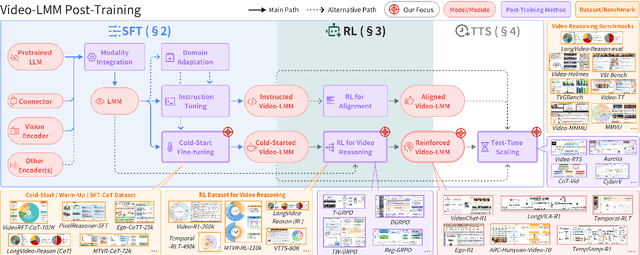
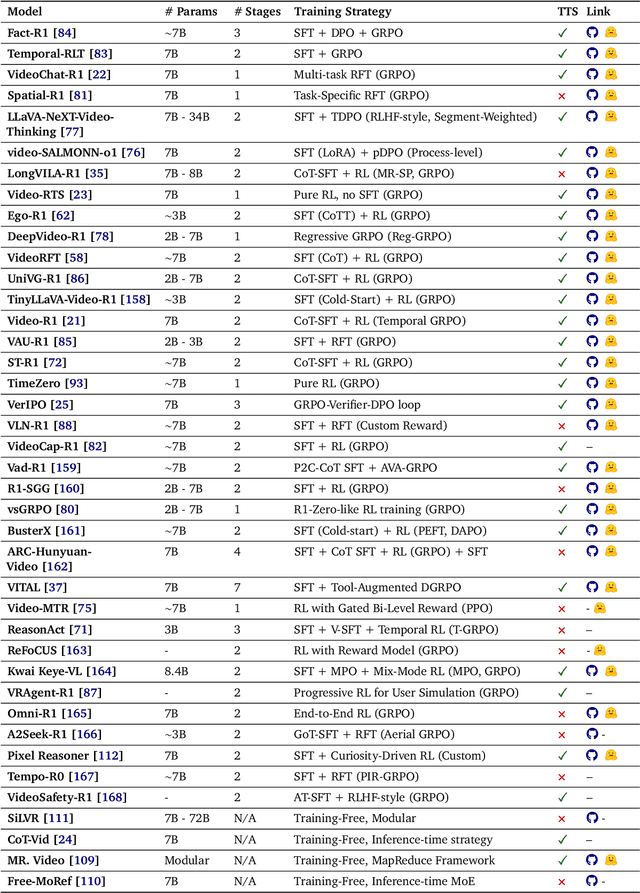
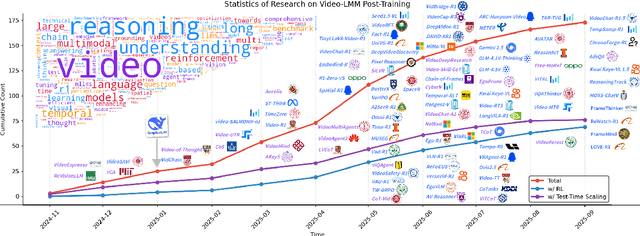
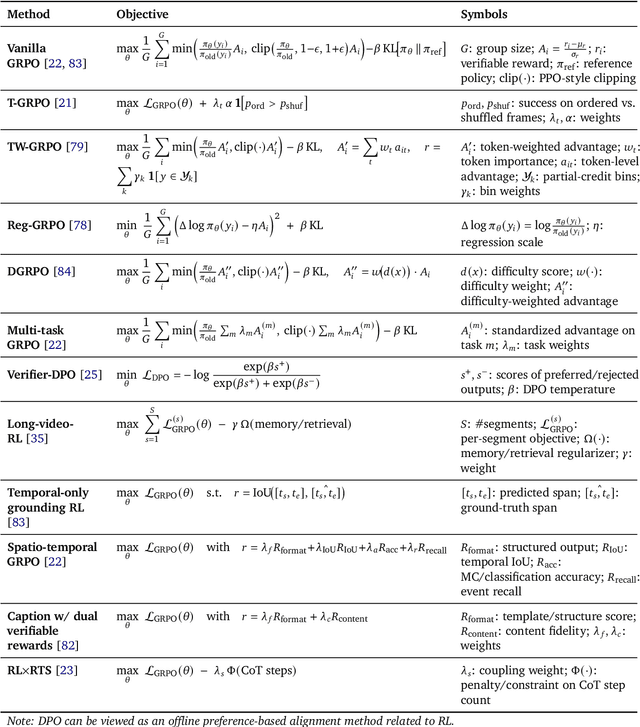
Abstract:Video understanding represents the most challenging frontier in computer vision, requiring models to reason about complex spatiotemporal relationships, long-term dependencies, and multimodal evidence. The recent emergence of Video-Large Multimodal Models (Video-LMMs), which integrate visual encoders with powerful decoder-based language models, has demonstrated remarkable capabilities in video understanding tasks. However, the critical phase that transforms these models from basic perception systems into sophisticated reasoning engines, post-training, remains fragmented across the literature. This survey provides the first comprehensive examination of post-training methodologies for Video-LMMs, encompassing three fundamental pillars: supervised fine-tuning (SFT) with chain-of-thought, reinforcement learning (RL) from verifiable objectives, and test-time scaling (TTS) through enhanced inference computation. We present a structured taxonomy that clarifies the roles, interconnections, and video-specific adaptations of these techniques, addressing unique challenges such as temporal localization, spatiotemporal grounding, long video efficiency, and multimodal evidence integration. Through systematic analysis of representative methods, we synthesize key design principles, insights, and evaluation protocols while identifying critical open challenges in reward design, scalability, and cost-performance optimization. We further curate essential benchmarks, datasets, and metrics to facilitate rigorous assessment of post-training effectiveness. This survey aims to provide researchers and practitioners with a unified framework for advancing Video-LMM capabilities. Additional resources and updates are maintained at: https://github.com/yunlong10/Awesome-Video-LMM-Post-Training
CasP: Improving Semi-Dense Feature Matching Pipeline Leveraging Cascaded Correspondence Priors for Guidance
Jul 23, 2025Abstract:Semi-dense feature matching methods have shown strong performance in challenging scenarios. However, the existing pipeline relies on a global search across the entire feature map to establish coarse matches, limiting further improvements in accuracy and efficiency. Motivated by this limitation, we propose a novel pipeline, CasP, which leverages cascaded correspondence priors for guidance. Specifically, the matching stage is decomposed into two progressive phases, bridged by a region-based selective cross-attention mechanism designed to enhance feature discriminability. In the second phase, one-to-one matches are determined by restricting the search range to the one-to-many prior areas identified in the first phase. Additionally, this pipeline benefits from incorporating high-level features, which helps reduce the computational costs of low-level feature extraction. The acceleration gains of CasP increase with higher resolution, and our lite model achieves a speedup of $\sim2.2\times$ at a resolution of 1152 compared to the most efficient method, ELoFTR. Furthermore, extensive experiments demonstrate its superiority in geometric estimation, particularly with impressive cross-domain generalization. These advantages highlight its potential for latency-sensitive and high-robustness applications, such as SLAM and UAV systems. Code is available at https://github.com/pq-chen/CasP.
DocCHA: Towards LLM-Augmented Interactive Online diagnosis System
Jul 10, 2025Abstract:Despite the impressive capabilities of Large Language Models (LLMs), existing Conversational Health Agents (CHAs) remain static and brittle, incapable of adaptive multi-turn reasoning, symptom clarification, or transparent decision-making. This hinders their real-world applicability in clinical diagnosis, where iterative and structured dialogue is essential. We propose DocCHA, a confidence-aware, modular framework that emulates clinical reasoning by decomposing the diagnostic process into three stages: (1) symptom elicitation, (2) history acquisition, and (3) causal graph construction. Each module uses interpretable confidence scores to guide adaptive questioning, prioritize informative clarifications, and refine weak reasoning links. Evaluated on two real-world Chinese consultation datasets (IMCS21, DX), DocCHA consistently outperforms strong prompting-based LLM baselines (GPT-3.5, GPT-4o, LLaMA-3), achieving up to 5.18 percent higher diagnostic accuracy and over 30 percent improvement in symptom recall, with only modest increase in dialogue turns. These results demonstrate the effectiveness of DocCHA in enabling structured, transparent, and efficient diagnostic conversations -- paving the way for trustworthy LLM-powered clinical assistants in multilingual and resource-constrained settings.
PreP-OCR: A Complete Pipeline for Document Image Restoration and Enhanced OCR Accuracy
May 28, 2025Abstract:This paper introduces PreP-OCR, a two-stage pipeline that combines document image restoration with semantic-aware post-OCR correction to enhance both visual clarity and textual consistency, thereby improving text extraction from degraded historical documents. First, we synthesize document-image pairs from plaintext, rendering them with diverse fonts and layouts and then applying a randomly ordered set of degradation operations. An image restoration model is trained on this synthetic data, using multi-directional patch extraction and fusion to process large images. Second, a ByT5 post-OCR model, fine-tuned on synthetic historical text pairs, addresses remaining OCR errors. Detailed experiments on 13,831 pages of real historical documents in English, French, and Spanish show that the PreP-OCR pipeline reduces character error rates by 63.9-70.3% compared to OCR on raw images. Our pipeline demonstrates the potential of integrating image restoration with linguistic error correction for digitizing historical archives.
UI-Evol: Automatic Knowledge Evolving for Computer Use Agents
May 28, 2025Abstract:External knowledge has played a crucial role in the recent development of computer use agents. We identify a critical knowledge-execution gap: retrieved knowledge often fails to translate into effective real-world task execution. Our analysis shows even 90\% correct knowledge yields only 41\% execution success rate. To bridge this gap, we propose UI-Evol, a plug-and-play module for autonomous GUI knowledge evolution. UI-Evol consists of two stages: a Retrace Stage that extracts faithful objective action sequences from actual agent-environment interactions, and a Critique Stage that refines existing knowledge by comparing these sequences against external references. We conduct comprehensive experiments on the OSWorld benchmark with the state-of-the-art Agent S2. Our results demonstrate that UI-Evol not only significantly boosts task performance but also addresses a previously overlooked issue of high behavioral standard deviation in computer use agents, leading to superior performance on computer use tasks and substantially improved agent reliability.
StereoINR: Cross-View Geometry Consistent Stereo Super Resolution with Implicit Neural Representation
May 07, 2025Abstract:Stereo image super-resolution (SSR) aims to enhance high-resolution details by leveraging information from stereo image pairs. However, existing stereo super-resolution (SSR) upsampling methods (e.g., pixel shuffle) often overlook cross-view geometric consistency and are limited to fixed-scale upsampling. The key issue is that previous upsampling methods use convolution to independently process deep features of different views, lacking cross-view and non-local information perception, making it difficult to select beneficial information from multi-view scenes adaptively. In this work, we propose Stereo Implicit Neural Representation (StereoINR), which innovatively models stereo image pairs as continuous implicit representations. This continuous representation breaks through the scale limitations, providing a unified solution for arbitrary-scale stereo super-resolution reconstruction of left-right views. Furthermore, by incorporating spatial warping and cross-attention mechanisms, StereoINR enables effective cross-view information fusion and achieves significant improvements in pixel-level geometric consistency. Extensive experiments across multiple datasets show that StereoINR outperforms out-of-training-distribution scale upsampling and matches state-of-the-art SSR methods within training-distribution scales.
Galvatron: An Automatic Distributed System for Efficient Foundation Model Training
Apr 30, 2025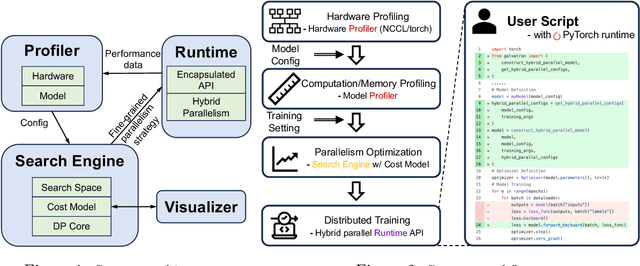
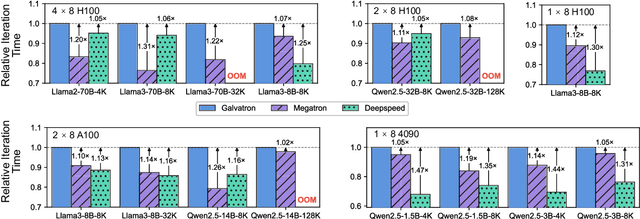
Abstract:Galvatron is a distributed system for efficiently training large-scale Foundation Models. It overcomes the complexities of selecting optimal parallelism strategies by automatically identifying the most efficient hybrid strategy, incorporating data, tensor, pipeline, sharded data, and sequence parallelism, along with recomputation. The system's architecture includes a profiler for hardware and model analysis, a search engine for strategy optimization using decision trees and dynamic programming, and a runtime for executing these strategies efficiently. Benchmarking on various clusters demonstrates Galvatron's superior throughput compared to existing frameworks. This open-source system offers user-friendly interfaces and comprehensive documentation, making complex distributed training accessible and efficient. The source code of Galvatron is available at https://github.com/PKU-DAIR/Hetu-Galvatron.
UI-E2I-Synth: Advancing GUI Grounding with Large-Scale Instruction Synthesis
Apr 16, 2025Abstract:Recent advancements in Large Vision-Language Models are accelerating the development of Graphical User Interface (GUI) agents that utilize human-like vision perception capabilities to enhance productivity on digital devices. Compared to approaches predicated on GUI metadata, which are platform-dependent and vulnerable to implementation variations, vision-based approaches offer broader applicability. In this vision-based paradigm, the GUI instruction grounding, which maps user instruction to the location of corresponding element on the given screenshot, remains a critical challenge, particularly due to limited public training dataset and resource-intensive manual instruction data annotation. In this paper, we delve into unexplored challenges in this task including element-to-screen ratio, unbalanced element type, and implicit instruction. To address these challenges, we introduce a large-scale data synthesis pipeline UI-E2I-Synth for generating varying complex instruction datasets using GPT-4o instead of human annotators. Furthermore, we propose a new GUI instruction grounding benchmark UI-I2E-Bench, which is designed to address the limitations of existing benchmarks by incorporating diverse annotation aspects. Our model, trained on the synthesized data, achieves superior performance in GUI instruction grounding, demonstrating the advancements of proposed data synthesis pipeline. The proposed benchmark, accompanied by extensive analyses, provides practical insights for future research in GUI grounding. We will release corresponding artifacts at https://colmon46.github.io/i2e-bench-leaderboard/ .
Feature Alignment with Equivariant Convolutions for Burst Image Super-Resolution
Mar 11, 2025Abstract:Burst image processing (BIP), which captures and integrates multiple frames into a single high-quality image, is widely used in consumer cameras. As a typical BIP task, Burst Image Super-Resolution (BISR) has achieved notable progress through deep learning in recent years. Existing BISR methods typically involve three key stages: alignment, upsampling, and fusion, often in varying orders and implementations. Among these stages, alignment is particularly critical for ensuring accurate feature matching and further reconstruction. However, existing methods often rely on techniques such as deformable convolutions and optical flow to realize alignment, which either focus only on local transformations or lack theoretical grounding, thereby limiting their performance. To alleviate these issues, we propose a novel framework for BISR, featuring an equivariant convolution-based alignment, ensuring consistent transformations between the image and feature domains. This enables the alignment transformation to be learned via explicit supervision in the image domain and easily applied in the feature domain in a theoretically sound way, effectively improving alignment accuracy. Additionally, we design an effective reconstruction module with advanced deep architectures for upsampling and fusion to obtain the final BISR result. Extensive experiments on BISR benchmarks show the superior performance of our approach in both quantitative metrics and visual quality.
Uncovering Cross-Domain Recommendation Ability of Large Language Models
Mar 10, 2025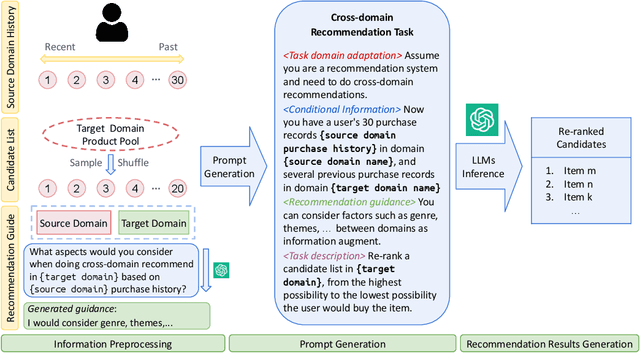


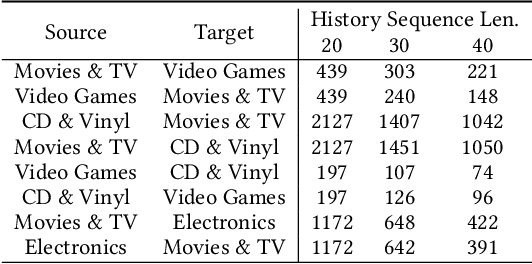
Abstract:Cross-Domain Recommendation (CDR) seeks to enhance item retrieval in low-resource domains by transferring knowledge from high-resource domains. While recent advancements in Large Language Models (LLMs) have demonstrated their potential in Recommender Systems (RS), their ability to effectively transfer domain knowledge for improved recommendations remains underexplored. To bridge this gap, we propose LLM4CDR, a novel CDR pipeline that constructs context-aware prompts by leveraging users' purchase history sequences from a source domain along with shared features between source and target domains. Through extensive experiments, we show that LLM4CDR achieves strong performance, particularly when using LLMs with large parameter sizes and when the source and target domains exhibit smaller domain gaps. For instance, incorporating CD and Vinyl purchase history for recommendations in Movies and TV yields a 64.28 percent MAP 1 improvement. We further investigate key factors including source domain data, domain gap, prompt design, and LLM size, which impact LLM4CDR's effectiveness in CDR tasks. Our results highlight that LLM4CDR excels when leveraging a single, closely related source domain and benefits significantly from larger LLMs. These insights pave the way for future research on LLM-driven cross-domain recommendations.
 Add to Chrome
Add to Chrome Add to Firefox
Add to Firefox Add to Edge
Add to Edge